Negligence and Duty of Care in Business
VerifiedAdded on 2020/05/16
|14
|3636
|205
AI Summary
This assignment examines a case study involving Alice, a businesswoman, and Marcos, who was injured in an accident caused by Alice's negligence. Students must analyze the situation to determine if Alice breached her duty of care, considering factors like age, prudence, and efficiency in decision-making. The analysis should draw upon legal principles from cases like McHale v Watson and Donoghue v Stevenson, highlighting the impact of Alice's actions on Marcos' well-being and potential legal consequences.
Contribute Materials
Your contribution can guide someone’s learning journey. Share your
documents today.
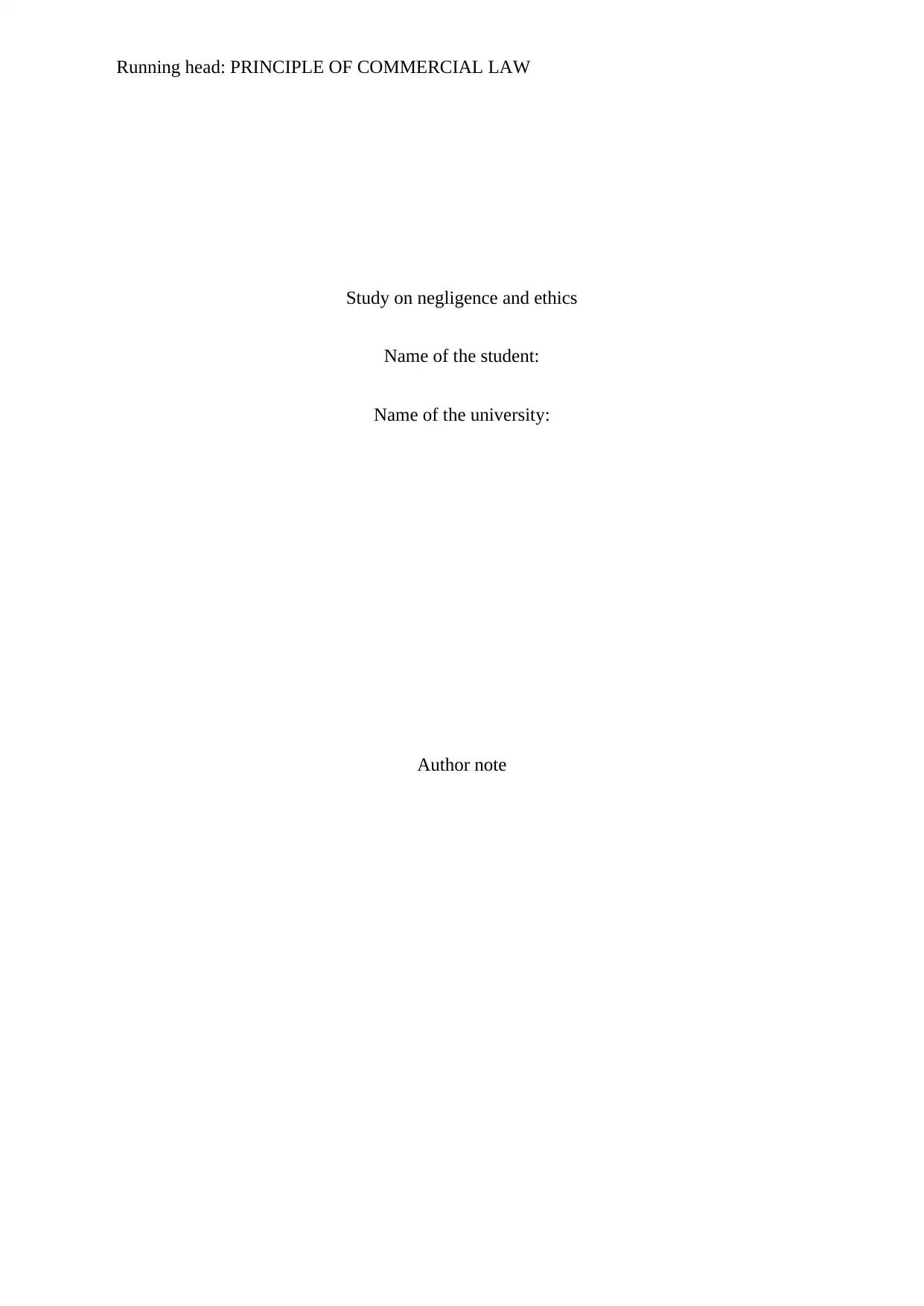
Running head: PRINCIPLE OF COMMERCIAL LAW
Study on negligence and ethics
Name of the student:
Name of the university:
Author note
Study on negligence and ethics
Name of the student:
Name of the university:
Author note
Secure Best Marks with AI Grader
Need help grading? Try our AI Grader for instant feedback on your assignments.
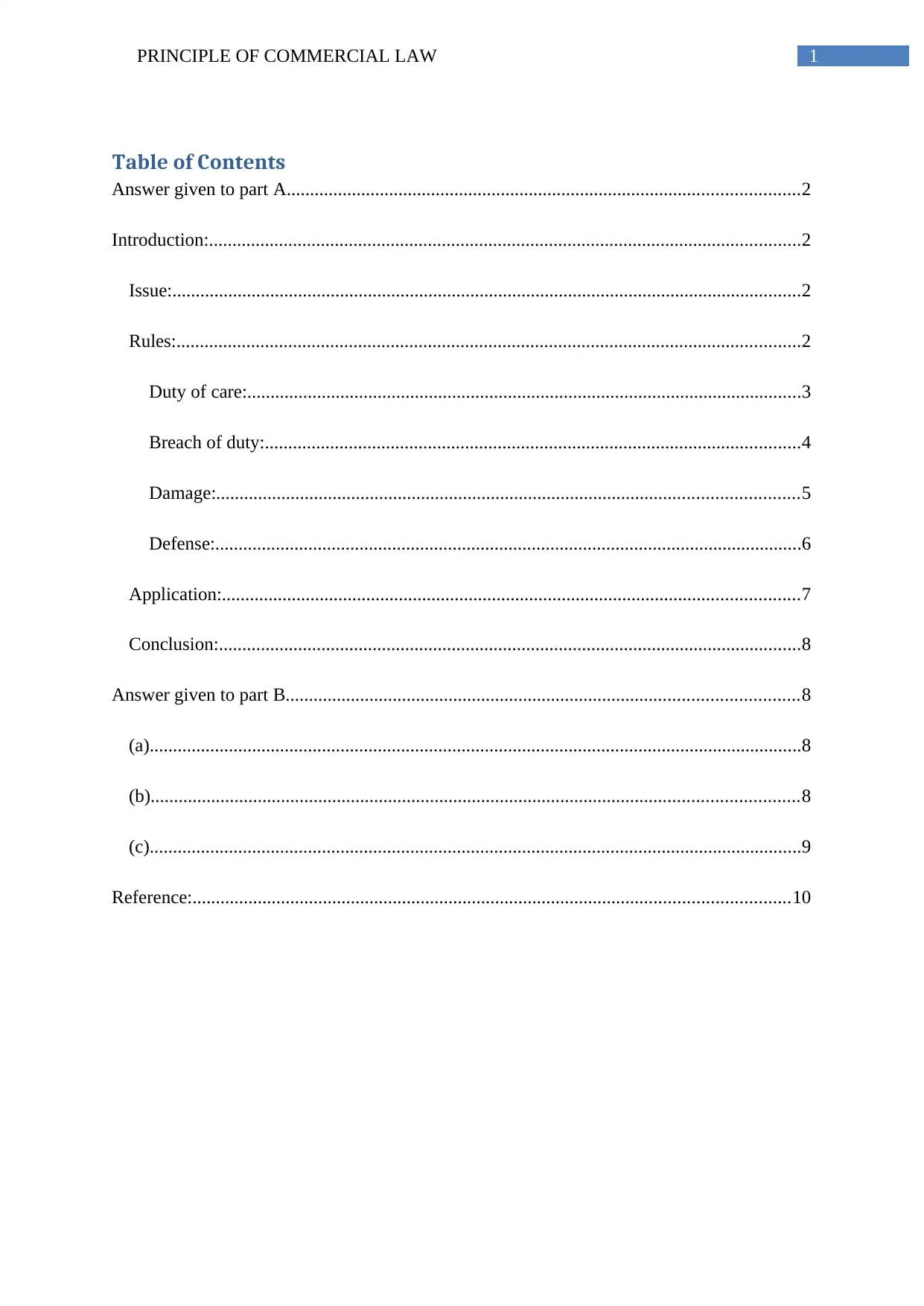
1PRINCIPLE OF COMMERCIAL LAW
Table of Contents
Answer given to part A..............................................................................................................2
Introduction:...............................................................................................................................2
Issue:.......................................................................................................................................2
Rules:......................................................................................................................................2
Duty of care:.......................................................................................................................3
Breach of duty:...................................................................................................................4
Damage:.............................................................................................................................5
Defense:..............................................................................................................................6
Application:............................................................................................................................7
Conclusion:.............................................................................................................................8
Answer given to part B..............................................................................................................8
(a)............................................................................................................................................8
(b)...........................................................................................................................................8
(c)............................................................................................................................................9
Reference:................................................................................................................................10
Table of Contents
Answer given to part A..............................................................................................................2
Introduction:...............................................................................................................................2
Issue:.......................................................................................................................................2
Rules:......................................................................................................................................2
Duty of care:.......................................................................................................................3
Breach of duty:...................................................................................................................4
Damage:.............................................................................................................................5
Defense:..............................................................................................................................6
Application:............................................................................................................................7
Conclusion:.............................................................................................................................8
Answer given to part B..............................................................................................................8
(a)............................................................................................................................................8
(b)...........................................................................................................................................8
(c)............................................................................................................................................9
Reference:................................................................................................................................10
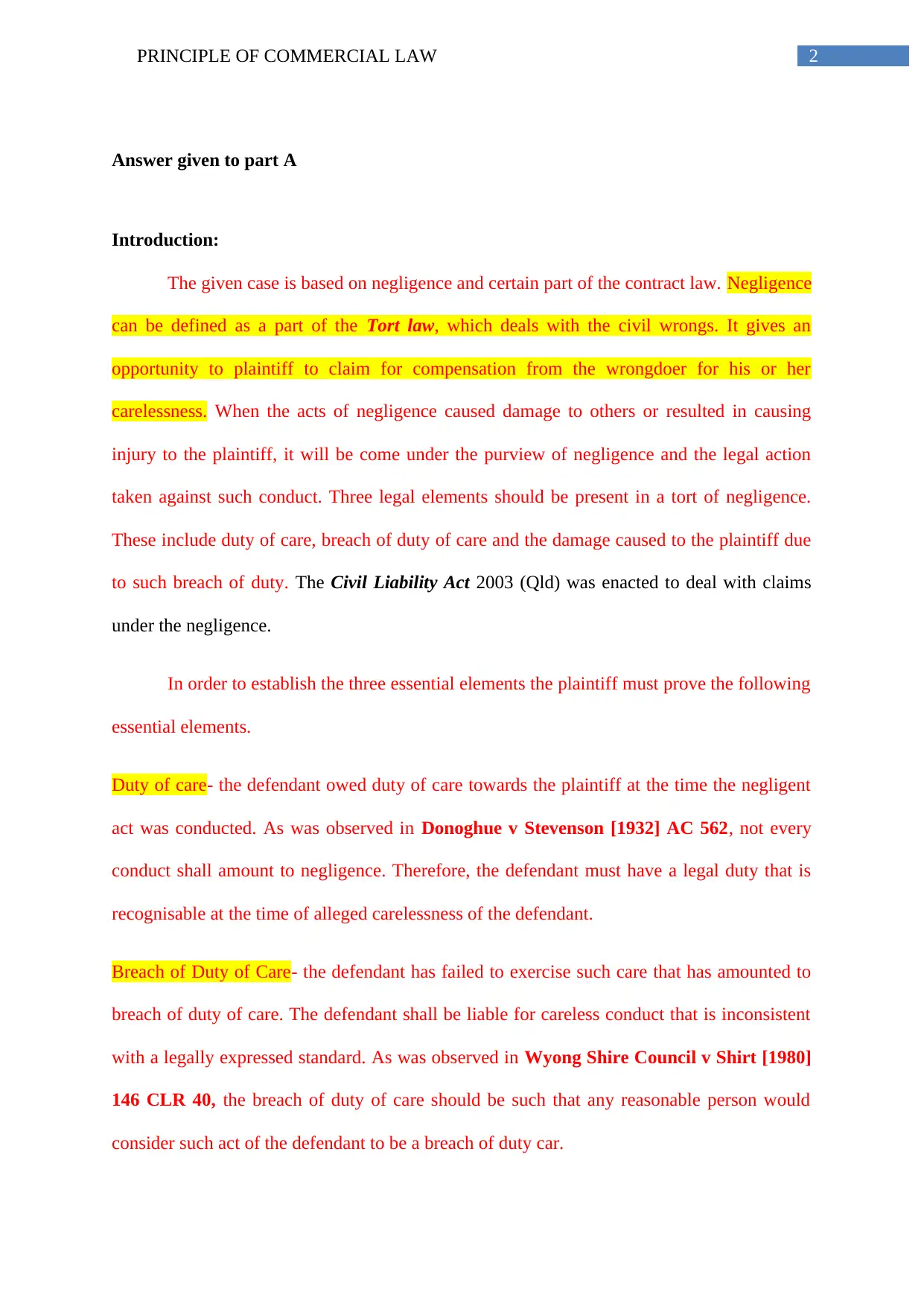
2PRINCIPLE OF COMMERCIAL LAW
Answer given to part A
Introduction:
The given case is based on negligence and certain part of the contract law. Negligence
can be defined as a part of the Tort law, which deals with the civil wrongs. It gives an
opportunity to plaintiff to claim for compensation from the wrongdoer for his or her
carelessness. When the acts of negligence caused damage to others or resulted in causing
injury to the plaintiff, it will be come under the purview of negligence and the legal action
taken against such conduct. Three legal elements should be present in a tort of negligence.
These include duty of care, breach of duty of care and the damage caused to the plaintiff due
to such breach of duty. The Civil Liability Act 2003 (Qld) was enacted to deal with claims
under the negligence.
In order to establish the three essential elements the plaintiff must prove the following
essential elements.
Duty of care- the defendant owed duty of care towards the plaintiff at the time the negligent
act was conducted. As was observed in Donoghue v Stevenson [1932] AC 562, not every
conduct shall amount to negligence. Therefore, the defendant must have a legal duty that is
recognisable at the time of alleged carelessness of the defendant.
Breach of Duty of Care- the defendant has failed to exercise such care that has amounted to
breach of duty of care. The defendant shall be liable for careless conduct that is inconsistent
with a legally expressed standard. As was observed in Wyong Shire Council v Shirt [1980]
146 CLR 40, the breach of duty of care should be such that any reasonable person would
consider such act of the defendant to be a breach of duty car.
Answer given to part A
Introduction:
The given case is based on negligence and certain part of the contract law. Negligence
can be defined as a part of the Tort law, which deals with the civil wrongs. It gives an
opportunity to plaintiff to claim for compensation from the wrongdoer for his or her
carelessness. When the acts of negligence caused damage to others or resulted in causing
injury to the plaintiff, it will be come under the purview of negligence and the legal action
taken against such conduct. Three legal elements should be present in a tort of negligence.
These include duty of care, breach of duty of care and the damage caused to the plaintiff due
to such breach of duty. The Civil Liability Act 2003 (Qld) was enacted to deal with claims
under the negligence.
In order to establish the three essential elements the plaintiff must prove the following
essential elements.
Duty of care- the defendant owed duty of care towards the plaintiff at the time the negligent
act was conducted. As was observed in Donoghue v Stevenson [1932] AC 562, not every
conduct shall amount to negligence. Therefore, the defendant must have a legal duty that is
recognisable at the time of alleged carelessness of the defendant.
Breach of Duty of Care- the defendant has failed to exercise such care that has amounted to
breach of duty of care. The defendant shall be liable for careless conduct that is inconsistent
with a legally expressed standard. As was observed in Wyong Shire Council v Shirt [1980]
146 CLR 40, the breach of duty of care should be such that any reasonable person would
consider such act of the defendant to be a breach of duty car.
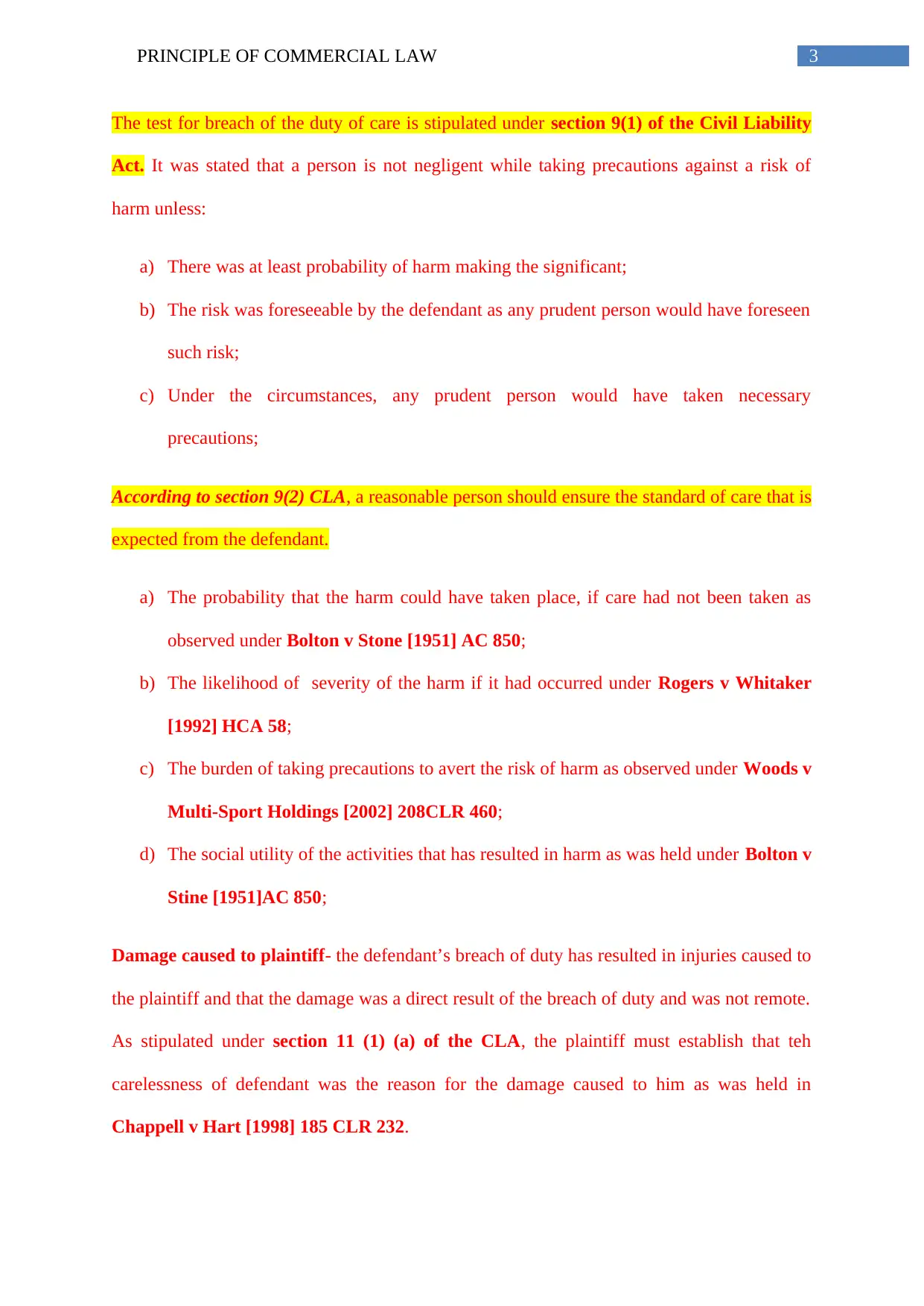
3PRINCIPLE OF COMMERCIAL LAW
The test for breach of the duty of care is stipulated under section 9(1) of the Civil Liability
Act. It was stated that a person is not negligent while taking precautions against a risk of
harm unless:
a) There was at least probability of harm making the significant;
b) The risk was foreseeable by the defendant as any prudent person would have foreseen
such risk;
c) Under the circumstances, any prudent person would have taken necessary
precautions;
According to section 9(2) CLA, a reasonable person should ensure the standard of care that is
expected from the defendant.
a) The probability that the harm could have taken place, if care had not been taken as
observed under Bolton v Stone [1951] AC 850;
b) The likelihood of severity of the harm if it had occurred under Rogers v Whitaker
[1992] HCA 58;
c) The burden of taking precautions to avert the risk of harm as observed under Woods v
Multi-Sport Holdings [2002] 208CLR 460;
d) The social utility of the activities that has resulted in harm as was held under Bolton v
Stine [1951]AC 850;
Damage caused to plaintiff- the defendant’s breach of duty has resulted in injuries caused to
the plaintiff and that the damage was a direct result of the breach of duty and was not remote.
As stipulated under section 11 (1) (a) of the CLA, the plaintiff must establish that teh
carelessness of defendant was the reason for the damage caused to him as was held in
Chappell v Hart [1998] 185 CLR 232.
The test for breach of the duty of care is stipulated under section 9(1) of the Civil Liability
Act. It was stated that a person is not negligent while taking precautions against a risk of
harm unless:
a) There was at least probability of harm making the significant;
b) The risk was foreseeable by the defendant as any prudent person would have foreseen
such risk;
c) Under the circumstances, any prudent person would have taken necessary
precautions;
According to section 9(2) CLA, a reasonable person should ensure the standard of care that is
expected from the defendant.
a) The probability that the harm could have taken place, if care had not been taken as
observed under Bolton v Stone [1951] AC 850;
b) The likelihood of severity of the harm if it had occurred under Rogers v Whitaker
[1992] HCA 58;
c) The burden of taking precautions to avert the risk of harm as observed under Woods v
Multi-Sport Holdings [2002] 208CLR 460;
d) The social utility of the activities that has resulted in harm as was held under Bolton v
Stine [1951]AC 850;
Damage caused to plaintiff- the defendant’s breach of duty has resulted in injuries caused to
the plaintiff and that the damage was a direct result of the breach of duty and was not remote.
As stipulated under section 11 (1) (a) of the CLA, the plaintiff must establish that teh
carelessness of defendant was the reason for the damage caused to him as was held in
Chappell v Hart [1998] 185 CLR 232.
Secure Best Marks with AI Grader
Need help grading? Try our AI Grader for instant feedback on your assignments.
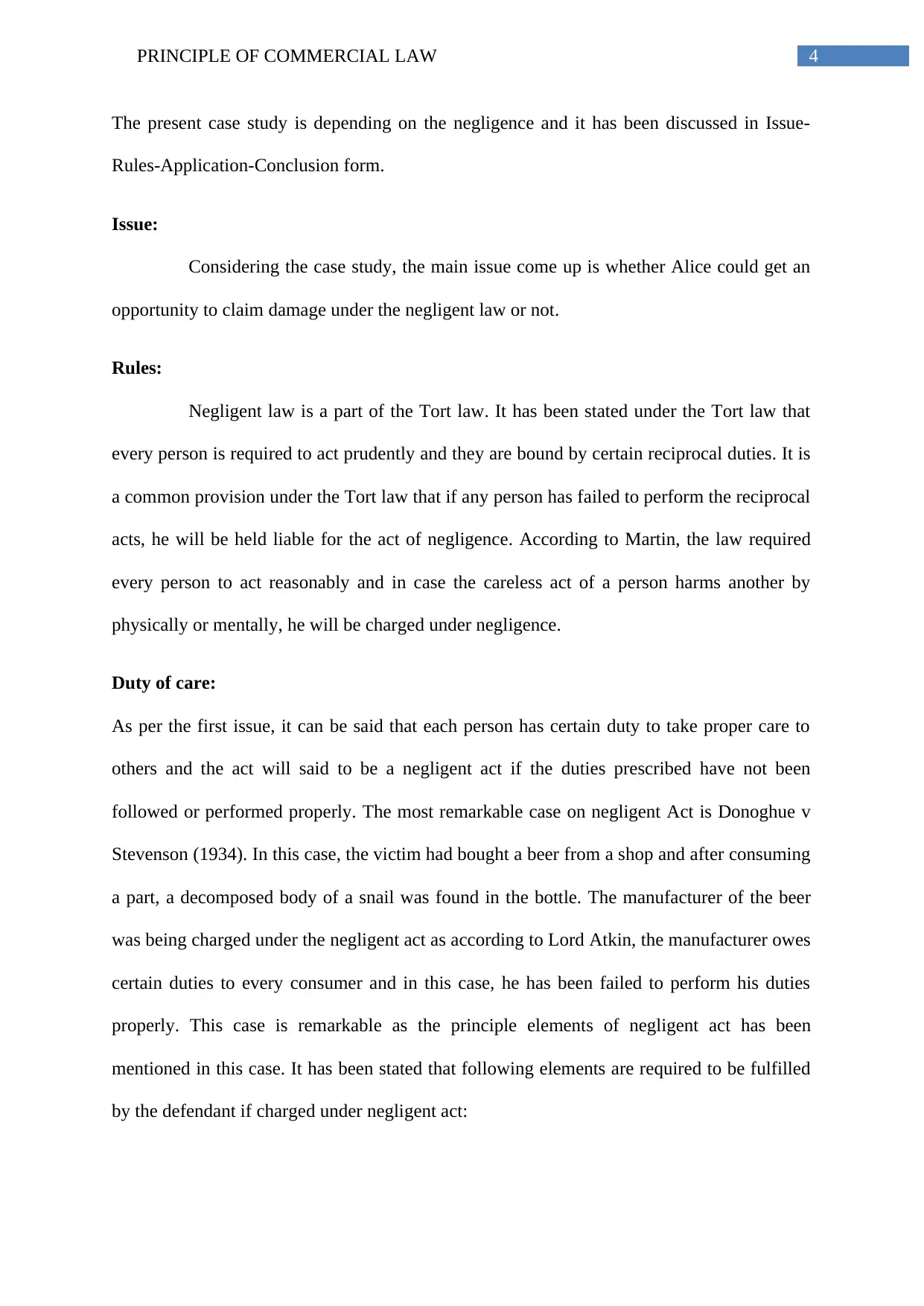
4PRINCIPLE OF COMMERCIAL LAW
The present case study is depending on the negligence and it has been discussed in Issue-
Rules-Application-Conclusion form.
Issue:
Considering the case study, the main issue come up is whether Alice could get an
opportunity to claim damage under the negligent law or not.
Rules:
Negligent law is a part of the Tort law. It has been stated under the Tort law that
every person is required to act prudently and they are bound by certain reciprocal duties. It is
a common provision under the Tort law that if any person has failed to perform the reciprocal
acts, he will be held liable for the act of negligence. According to Martin, the law required
every person to act reasonably and in case the careless act of a person harms another by
physically or mentally, he will be charged under negligence.
Duty of care:
As per the first issue, it can be said that each person has certain duty to take proper care to
others and the act will said to be a negligent act if the duties prescribed have not been
followed or performed properly. The most remarkable case on negligent Act is Donoghue v
Stevenson (1934). In this case, the victim had bought a beer from a shop and after consuming
a part, a decomposed body of a snail was found in the bottle. The manufacturer of the beer
was being charged under the negligent act as according to Lord Atkin, the manufacturer owes
certain duties to every consumer and in this case, he has been failed to perform his duties
properly. This case is remarkable as the principle elements of negligent act has been
mentioned in this case. It has been stated that following elements are required to be fulfilled
by the defendant if charged under negligent act:
The present case study is depending on the negligence and it has been discussed in Issue-
Rules-Application-Conclusion form.
Issue:
Considering the case study, the main issue come up is whether Alice could get an
opportunity to claim damage under the negligent law or not.
Rules:
Negligent law is a part of the Tort law. It has been stated under the Tort law that
every person is required to act prudently and they are bound by certain reciprocal duties. It is
a common provision under the Tort law that if any person has failed to perform the reciprocal
acts, he will be held liable for the act of negligence. According to Martin, the law required
every person to act reasonably and in case the careless act of a person harms another by
physically or mentally, he will be charged under negligence.
Duty of care:
As per the first issue, it can be said that each person has certain duty to take proper care to
others and the act will said to be a negligent act if the duties prescribed have not been
followed or performed properly. The most remarkable case on negligent Act is Donoghue v
Stevenson (1934). In this case, the victim had bought a beer from a shop and after consuming
a part, a decomposed body of a snail was found in the bottle. The manufacturer of the beer
was being charged under the negligent act as according to Lord Atkin, the manufacturer owes
certain duties to every consumer and in this case, he has been failed to perform his duties
properly. This case is remarkable as the principle elements of negligent act has been
mentioned in this case. It has been stated that following elements are required to be fulfilled
by the defendant if charged under negligent act:
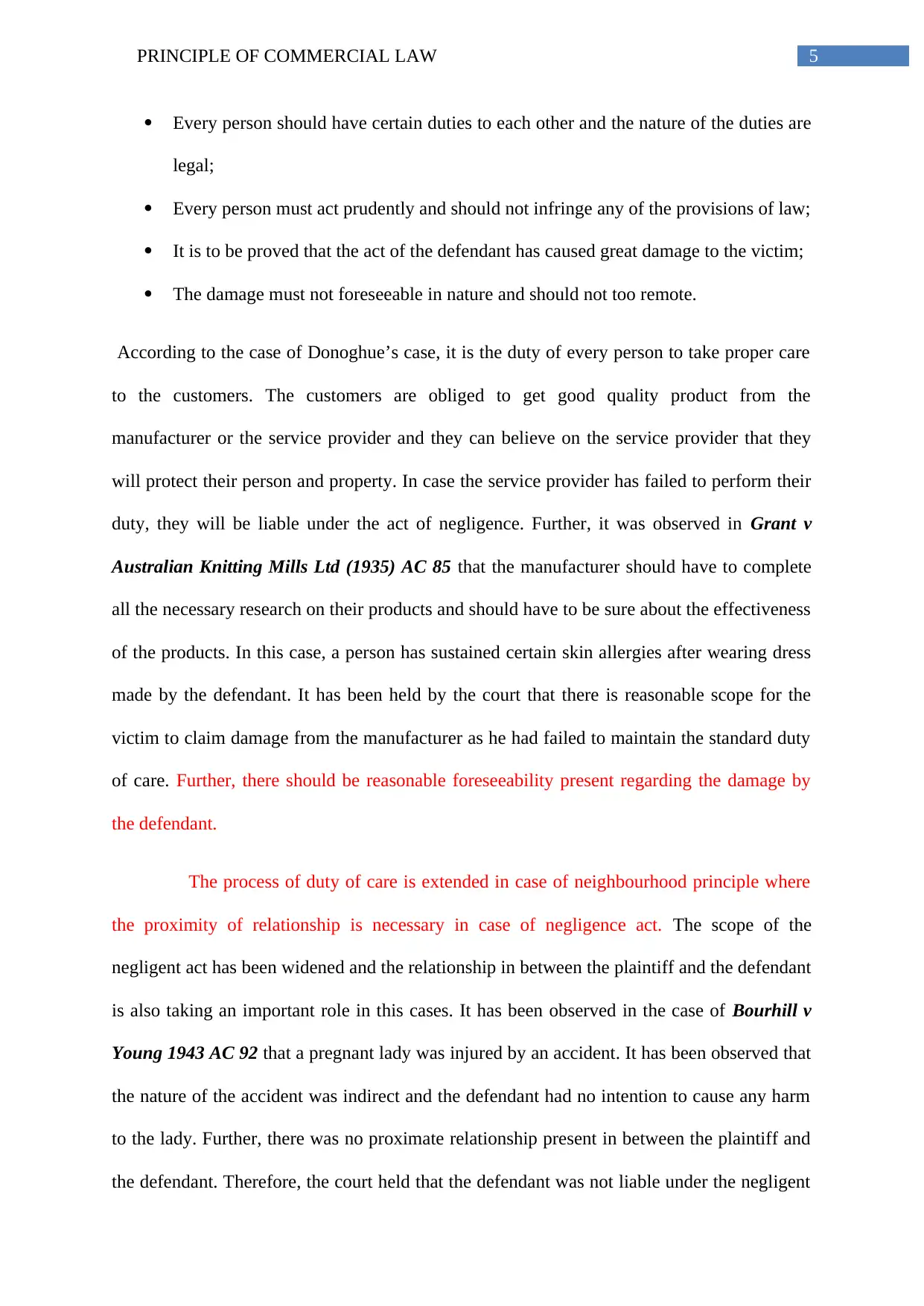
5PRINCIPLE OF COMMERCIAL LAW
Every person should have certain duties to each other and the nature of the duties are
legal;
Every person must act prudently and should not infringe any of the provisions of law;
It is to be proved that the act of the defendant has caused great damage to the victim;
The damage must not foreseeable in nature and should not too remote.
According to the case of Donoghue’s case, it is the duty of every person to take proper care
to the customers. The customers are obliged to get good quality product from the
manufacturer or the service provider and they can believe on the service provider that they
will protect their person and property. In case the service provider has failed to perform their
duty, they will be liable under the act of negligence. Further, it was observed in Grant v
Australian Knitting Mills Ltd (1935) AC 85 that the manufacturer should have to complete
all the necessary research on their products and should have to be sure about the effectiveness
of the products. In this case, a person has sustained certain skin allergies after wearing dress
made by the defendant. It has been held by the court that there is reasonable scope for the
victim to claim damage from the manufacturer as he had failed to maintain the standard duty
of care. Further, there should be reasonable foreseeability present regarding the damage by
the defendant.
The process of duty of care is extended in case of neighbourhood principle where
the proximity of relationship is necessary in case of negligence act. The scope of the
negligent act has been widened and the relationship in between the plaintiff and the defendant
is also taking an important role in this cases. It has been observed in the case of Bourhill v
Young 1943 AC 92 that a pregnant lady was injured by an accident. It has been observed that
the nature of the accident was indirect and the defendant had no intention to cause any harm
to the lady. Further, there was no proximate relationship present in between the plaintiff and
the defendant. Therefore, the court held that the defendant was not liable under the negligent
Every person should have certain duties to each other and the nature of the duties are
legal;
Every person must act prudently and should not infringe any of the provisions of law;
It is to be proved that the act of the defendant has caused great damage to the victim;
The damage must not foreseeable in nature and should not too remote.
According to the case of Donoghue’s case, it is the duty of every person to take proper care
to the customers. The customers are obliged to get good quality product from the
manufacturer or the service provider and they can believe on the service provider that they
will protect their person and property. In case the service provider has failed to perform their
duty, they will be liable under the act of negligence. Further, it was observed in Grant v
Australian Knitting Mills Ltd (1935) AC 85 that the manufacturer should have to complete
all the necessary research on their products and should have to be sure about the effectiveness
of the products. In this case, a person has sustained certain skin allergies after wearing dress
made by the defendant. It has been held by the court that there is reasonable scope for the
victim to claim damage from the manufacturer as he had failed to maintain the standard duty
of care. Further, there should be reasonable foreseeability present regarding the damage by
the defendant.
The process of duty of care is extended in case of neighbourhood principle where
the proximity of relationship is necessary in case of negligence act. The scope of the
negligent act has been widened and the relationship in between the plaintiff and the defendant
is also taking an important role in this cases. It has been observed in the case of Bourhill v
Young 1943 AC 92 that a pregnant lady was injured by an accident. It has been observed that
the nature of the accident was indirect and the defendant had no intention to cause any harm
to the lady. Further, there was no proximate relationship present in between the plaintiff and
the defendant. Therefore, the court held that the defendant was not liable under the negligent
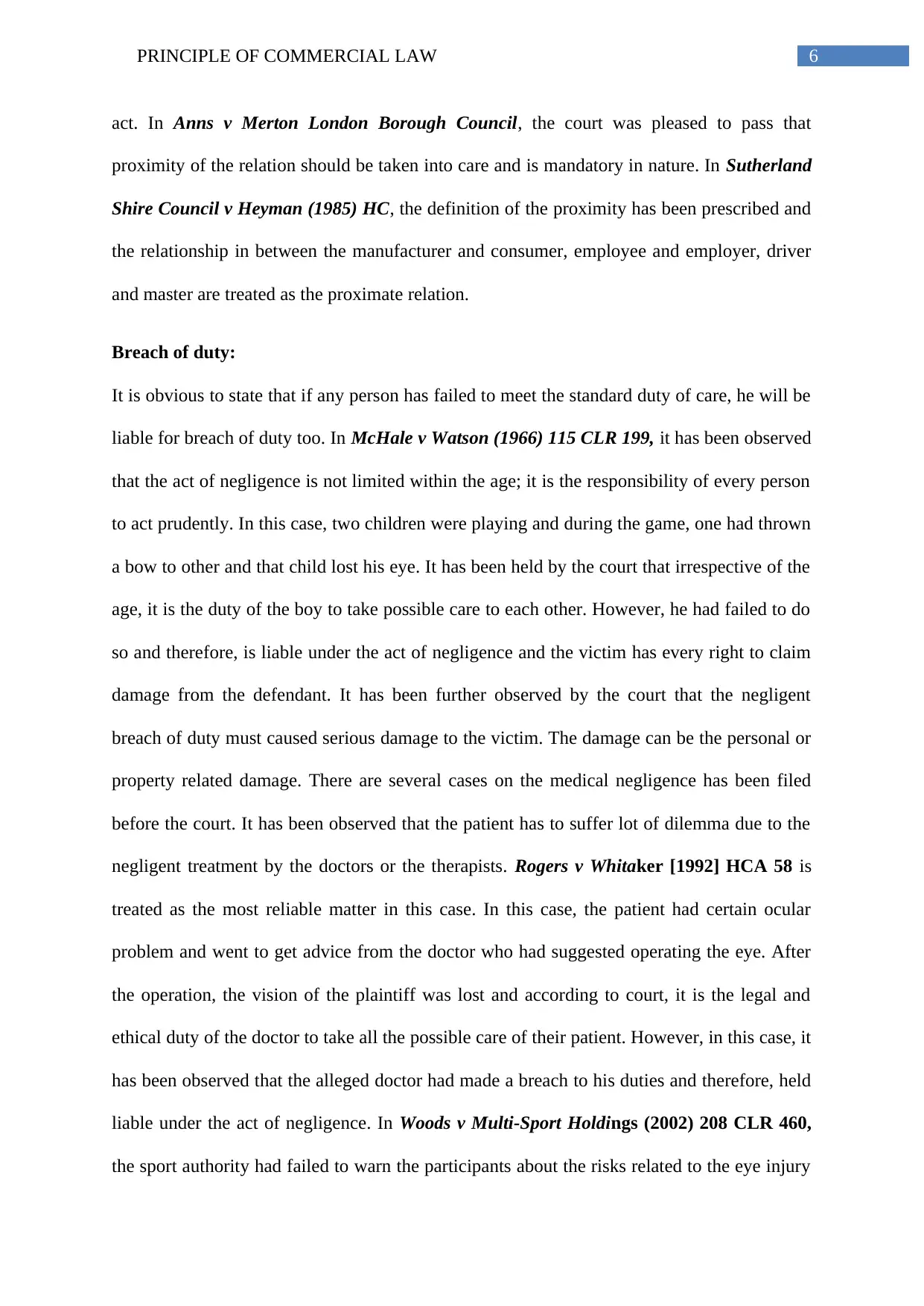
6PRINCIPLE OF COMMERCIAL LAW
act. In Anns v Merton London Borough Council, the court was pleased to pass that
proximity of the relation should be taken into care and is mandatory in nature. In Sutherland
Shire Council v Heyman (1985) HC, the definition of the proximity has been prescribed and
the relationship in between the manufacturer and consumer, employee and employer, driver
and master are treated as the proximate relation.
Breach of duty:
It is obvious to state that if any person has failed to meet the standard duty of care, he will be
liable for breach of duty too. In McHale v Watson (1966) 115 CLR 199, it has been observed
that the act of negligence is not limited within the age; it is the responsibility of every person
to act prudently. In this case, two children were playing and during the game, one had thrown
a bow to other and that child lost his eye. It has been held by the court that irrespective of the
age, it is the duty of the boy to take possible care to each other. However, he had failed to do
so and therefore, is liable under the act of negligence and the victim has every right to claim
damage from the defendant. It has been further observed by the court that the negligent
breach of duty must caused serious damage to the victim. The damage can be the personal or
property related damage. There are several cases on the medical negligence has been filed
before the court. It has been observed that the patient has to suffer lot of dilemma due to the
negligent treatment by the doctors or the therapists. Rogers v Whitaker [1992] HCA 58 is
treated as the most reliable matter in this case. In this case, the patient had certain ocular
problem and went to get advice from the doctor who had suggested operating the eye. After
the operation, the vision of the plaintiff was lost and according to court, it is the legal and
ethical duty of the doctor to take all the possible care of their patient. However, in this case, it
has been observed that the alleged doctor had made a breach to his duties and therefore, held
liable under the act of negligence. In Woods v Multi-Sport Holdings (2002) 208 CLR 460,
the sport authority had failed to warn the participants about the risks related to the eye injury
act. In Anns v Merton London Borough Council, the court was pleased to pass that
proximity of the relation should be taken into care and is mandatory in nature. In Sutherland
Shire Council v Heyman (1985) HC, the definition of the proximity has been prescribed and
the relationship in between the manufacturer and consumer, employee and employer, driver
and master are treated as the proximate relation.
Breach of duty:
It is obvious to state that if any person has failed to meet the standard duty of care, he will be
liable for breach of duty too. In McHale v Watson (1966) 115 CLR 199, it has been observed
that the act of negligence is not limited within the age; it is the responsibility of every person
to act prudently. In this case, two children were playing and during the game, one had thrown
a bow to other and that child lost his eye. It has been held by the court that irrespective of the
age, it is the duty of the boy to take possible care to each other. However, he had failed to do
so and therefore, is liable under the act of negligence and the victim has every right to claim
damage from the defendant. It has been further observed by the court that the negligent
breach of duty must caused serious damage to the victim. The damage can be the personal or
property related damage. There are several cases on the medical negligence has been filed
before the court. It has been observed that the patient has to suffer lot of dilemma due to the
negligent treatment by the doctors or the therapists. Rogers v Whitaker [1992] HCA 58 is
treated as the most reliable matter in this case. In this case, the patient had certain ocular
problem and went to get advice from the doctor who had suggested operating the eye. After
the operation, the vision of the plaintiff was lost and according to court, it is the legal and
ethical duty of the doctor to take all the possible care of their patient. However, in this case, it
has been observed that the alleged doctor had made a breach to his duties and therefore, held
liable under the act of negligence. In Woods v Multi-Sport Holdings (2002) 208 CLR 460,
the sport authority had failed to warn the participants about the risks related to the eye injury
Paraphrase This Document
Need a fresh take? Get an instant paraphrase of this document with our AI Paraphraser
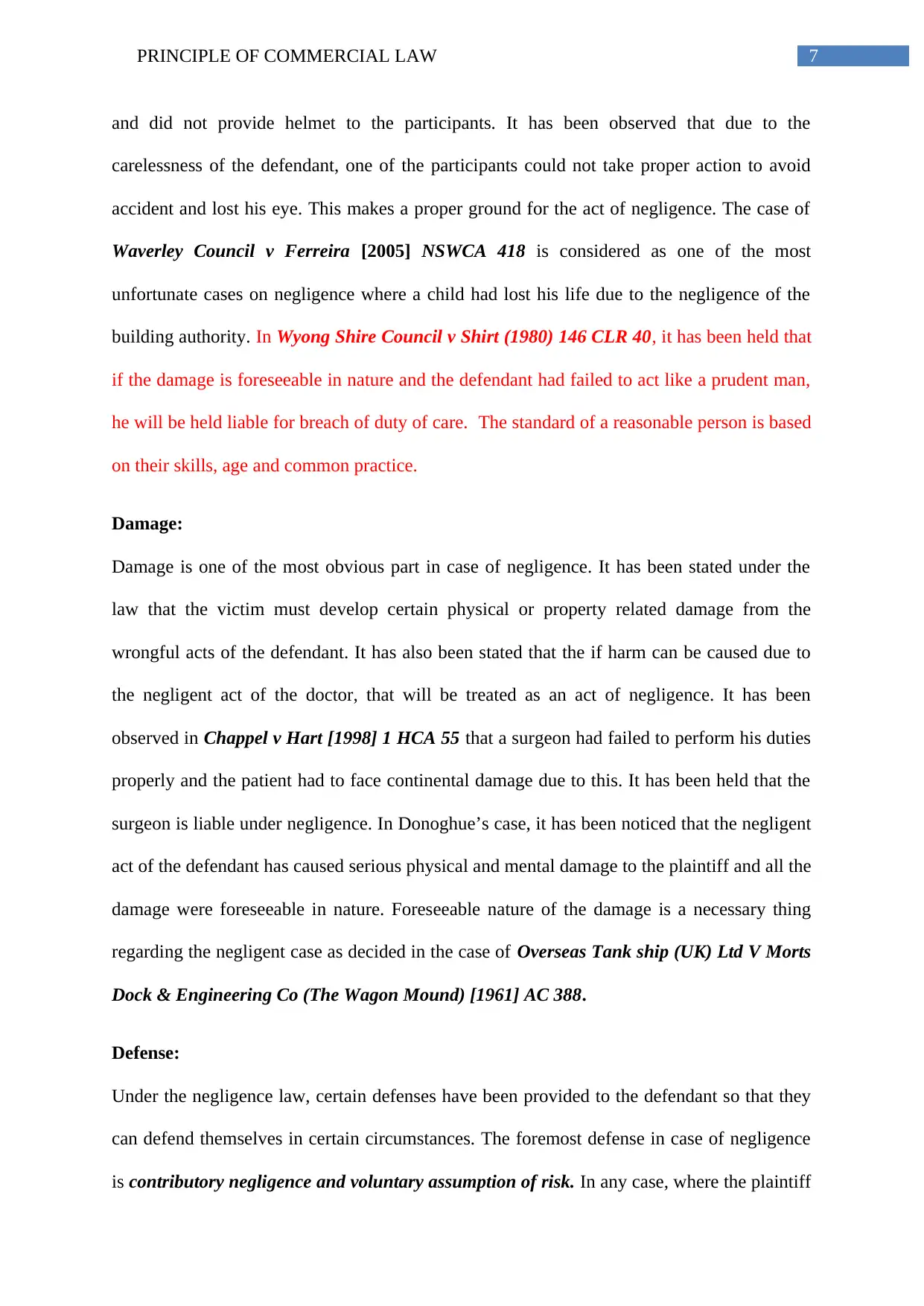
7PRINCIPLE OF COMMERCIAL LAW
and did not provide helmet to the participants. It has been observed that due to the
carelessness of the defendant, one of the participants could not take proper action to avoid
accident and lost his eye. This makes a proper ground for the act of negligence. The case of
Waverley Council v Ferreira [2005] NSWCA 418 is considered as one of the most
unfortunate cases on negligence where a child had lost his life due to the negligence of the
building authority. In Wyong Shire Council v Shirt (1980) 146 CLR 40, it has been held that
if the damage is foreseeable in nature and the defendant had failed to act like a prudent man,
he will be held liable for breach of duty of care. The standard of a reasonable person is based
on their skills, age and common practice.
Damage:
Damage is one of the most obvious part in case of negligence. It has been stated under the
law that the victim must develop certain physical or property related damage from the
wrongful acts of the defendant. It has also been stated that the if harm can be caused due to
the negligent act of the doctor, that will be treated as an act of negligence. It has been
observed in Chappel v Hart [1998] 1 HCA 55 that a surgeon had failed to perform his duties
properly and the patient had to face continental damage due to this. It has been held that the
surgeon is liable under negligence. In Donoghue’s case, it has been noticed that the negligent
act of the defendant has caused serious physical and mental damage to the plaintiff and all the
damage were foreseeable in nature. Foreseeable nature of the damage is a necessary thing
regarding the negligent case as decided in the case of Overseas Tank ship (UK) Ltd V Morts
Dock & Engineering Co (The Wagon Mound) [1961] AC 388.
Defense:
Under the negligence law, certain defenses have been provided to the defendant so that they
can defend themselves in certain circumstances. The foremost defense in case of negligence
is contributory negligence and voluntary assumption of risk. In any case, where the plaintiff
and did not provide helmet to the participants. It has been observed that due to the
carelessness of the defendant, one of the participants could not take proper action to avoid
accident and lost his eye. This makes a proper ground for the act of negligence. The case of
Waverley Council v Ferreira [2005] NSWCA 418 is considered as one of the most
unfortunate cases on negligence where a child had lost his life due to the negligence of the
building authority. In Wyong Shire Council v Shirt (1980) 146 CLR 40, it has been held that
if the damage is foreseeable in nature and the defendant had failed to act like a prudent man,
he will be held liable for breach of duty of care. The standard of a reasonable person is based
on their skills, age and common practice.
Damage:
Damage is one of the most obvious part in case of negligence. It has been stated under the
law that the victim must develop certain physical or property related damage from the
wrongful acts of the defendant. It has also been stated that the if harm can be caused due to
the negligent act of the doctor, that will be treated as an act of negligence. It has been
observed in Chappel v Hart [1998] 1 HCA 55 that a surgeon had failed to perform his duties
properly and the patient had to face continental damage due to this. It has been held that the
surgeon is liable under negligence. In Donoghue’s case, it has been noticed that the negligent
act of the defendant has caused serious physical and mental damage to the plaintiff and all the
damage were foreseeable in nature. Foreseeable nature of the damage is a necessary thing
regarding the negligent case as decided in the case of Overseas Tank ship (UK) Ltd V Morts
Dock & Engineering Co (The Wagon Mound) [1961] AC 388.
Defense:
Under the negligence law, certain defenses have been provided to the defendant so that they
can defend themselves in certain circumstances. The foremost defense in case of negligence
is contributory negligence and voluntary assumption of risk. In any case, where the plaintiff
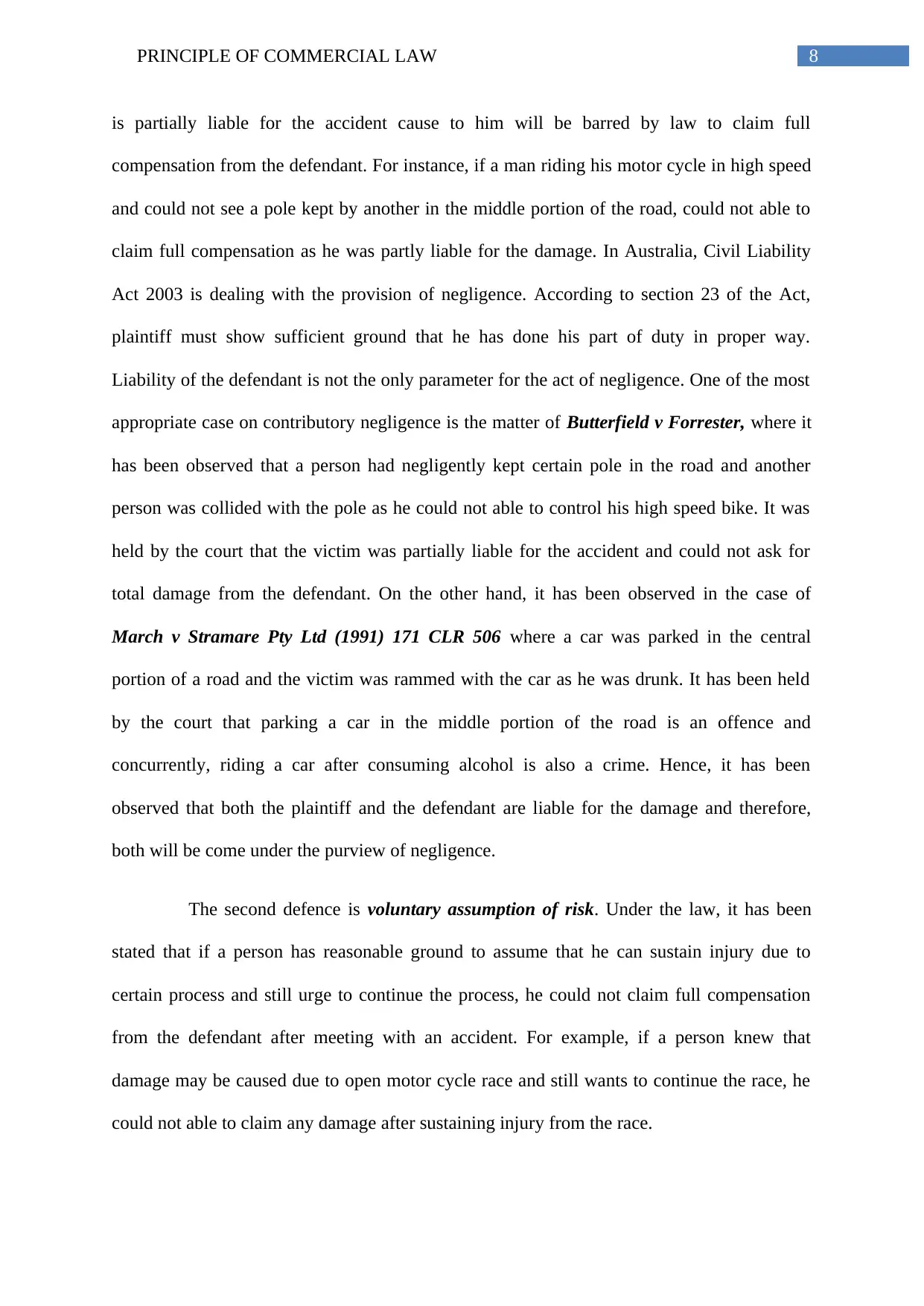
8PRINCIPLE OF COMMERCIAL LAW
is partially liable for the accident cause to him will be barred by law to claim full
compensation from the defendant. For instance, if a man riding his motor cycle in high speed
and could not see a pole kept by another in the middle portion of the road, could not able to
claim full compensation as he was partly liable for the damage. In Australia, Civil Liability
Act 2003 is dealing with the provision of negligence. According to section 23 of the Act,
plaintiff must show sufficient ground that he has done his part of duty in proper way.
Liability of the defendant is not the only parameter for the act of negligence. One of the most
appropriate case on contributory negligence is the matter of Butterfield v Forrester, where it
has been observed that a person had negligently kept certain pole in the road and another
person was collided with the pole as he could not able to control his high speed bike. It was
held by the court that the victim was partially liable for the accident and could not ask for
total damage from the defendant. On the other hand, it has been observed in the case of
March v Stramare Pty Ltd (1991) 171 CLR 506 where a car was parked in the central
portion of a road and the victim was rammed with the car as he was drunk. It has been held
by the court that parking a car in the middle portion of the road is an offence and
concurrently, riding a car after consuming alcohol is also a crime. Hence, it has been
observed that both the plaintiff and the defendant are liable for the damage and therefore,
both will be come under the purview of negligence.
The second defence is voluntary assumption of risk. Under the law, it has been
stated that if a person has reasonable ground to assume that he can sustain injury due to
certain process and still urge to continue the process, he could not claim full compensation
from the defendant after meeting with an accident. For example, if a person knew that
damage may be caused due to open motor cycle race and still wants to continue the race, he
could not able to claim any damage after sustaining injury from the race.
is partially liable for the accident cause to him will be barred by law to claim full
compensation from the defendant. For instance, if a man riding his motor cycle in high speed
and could not see a pole kept by another in the middle portion of the road, could not able to
claim full compensation as he was partly liable for the damage. In Australia, Civil Liability
Act 2003 is dealing with the provision of negligence. According to section 23 of the Act,
plaintiff must show sufficient ground that he has done his part of duty in proper way.
Liability of the defendant is not the only parameter for the act of negligence. One of the most
appropriate case on contributory negligence is the matter of Butterfield v Forrester, where it
has been observed that a person had negligently kept certain pole in the road and another
person was collided with the pole as he could not able to control his high speed bike. It was
held by the court that the victim was partially liable for the accident and could not ask for
total damage from the defendant. On the other hand, it has been observed in the case of
March v Stramare Pty Ltd (1991) 171 CLR 506 where a car was parked in the central
portion of a road and the victim was rammed with the car as he was drunk. It has been held
by the court that parking a car in the middle portion of the road is an offence and
concurrently, riding a car after consuming alcohol is also a crime. Hence, it has been
observed that both the plaintiff and the defendant are liable for the damage and therefore,
both will be come under the purview of negligence.
The second defence is voluntary assumption of risk. Under the law, it has been
stated that if a person has reasonable ground to assume that he can sustain injury due to
certain process and still urge to continue the process, he could not claim full compensation
from the defendant after meeting with an accident. For example, if a person knew that
damage may be caused due to open motor cycle race and still wants to continue the race, he
could not able to claim any damage after sustaining injury from the race.
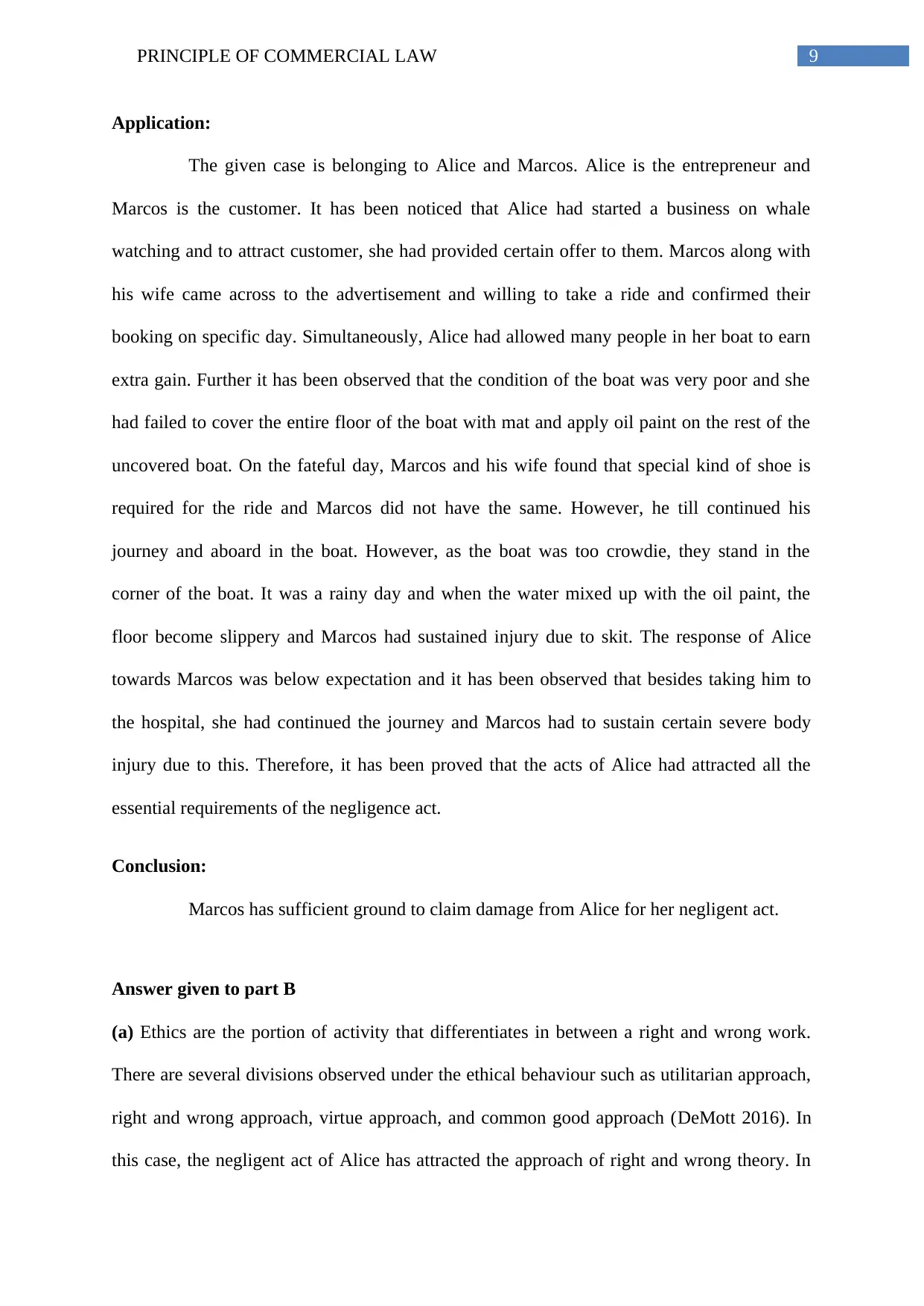
9PRINCIPLE OF COMMERCIAL LAW
Application:
The given case is belonging to Alice and Marcos. Alice is the entrepreneur and
Marcos is the customer. It has been noticed that Alice had started a business on whale
watching and to attract customer, she had provided certain offer to them. Marcos along with
his wife came across to the advertisement and willing to take a ride and confirmed their
booking on specific day. Simultaneously, Alice had allowed many people in her boat to earn
extra gain. Further it has been observed that the condition of the boat was very poor and she
had failed to cover the entire floor of the boat with mat and apply oil paint on the rest of the
uncovered boat. On the fateful day, Marcos and his wife found that special kind of shoe is
required for the ride and Marcos did not have the same. However, he till continued his
journey and aboard in the boat. However, as the boat was too crowdie, they stand in the
corner of the boat. It was a rainy day and when the water mixed up with the oil paint, the
floor become slippery and Marcos had sustained injury due to skit. The response of Alice
towards Marcos was below expectation and it has been observed that besides taking him to
the hospital, she had continued the journey and Marcos had to sustain certain severe body
injury due to this. Therefore, it has been proved that the acts of Alice had attracted all the
essential requirements of the negligence act.
Conclusion:
Marcos has sufficient ground to claim damage from Alice for her negligent act.
Answer given to part B
(a) Ethics are the portion of activity that differentiates in between a right and wrong work.
There are several divisions observed under the ethical behaviour such as utilitarian approach,
right and wrong approach, virtue approach, and common good approach (DeMott 2016). In
this case, the negligent act of Alice has attracted the approach of right and wrong theory. In
Application:
The given case is belonging to Alice and Marcos. Alice is the entrepreneur and
Marcos is the customer. It has been noticed that Alice had started a business on whale
watching and to attract customer, she had provided certain offer to them. Marcos along with
his wife came across to the advertisement and willing to take a ride and confirmed their
booking on specific day. Simultaneously, Alice had allowed many people in her boat to earn
extra gain. Further it has been observed that the condition of the boat was very poor and she
had failed to cover the entire floor of the boat with mat and apply oil paint on the rest of the
uncovered boat. On the fateful day, Marcos and his wife found that special kind of shoe is
required for the ride and Marcos did not have the same. However, he till continued his
journey and aboard in the boat. However, as the boat was too crowdie, they stand in the
corner of the boat. It was a rainy day and when the water mixed up with the oil paint, the
floor become slippery and Marcos had sustained injury due to skit. The response of Alice
towards Marcos was below expectation and it has been observed that besides taking him to
the hospital, she had continued the journey and Marcos had to sustain certain severe body
injury due to this. Therefore, it has been proved that the acts of Alice had attracted all the
essential requirements of the negligence act.
Conclusion:
Marcos has sufficient ground to claim damage from Alice for her negligent act.
Answer given to part B
(a) Ethics are the portion of activity that differentiates in between a right and wrong work.
There are several divisions observed under the ethical behaviour such as utilitarian approach,
right and wrong approach, virtue approach, and common good approach (DeMott 2016). In
this case, the negligent act of Alice has attracted the approach of right and wrong theory. In
Secure Best Marks with AI Grader
Need help grading? Try our AI Grader for instant feedback on your assignments.
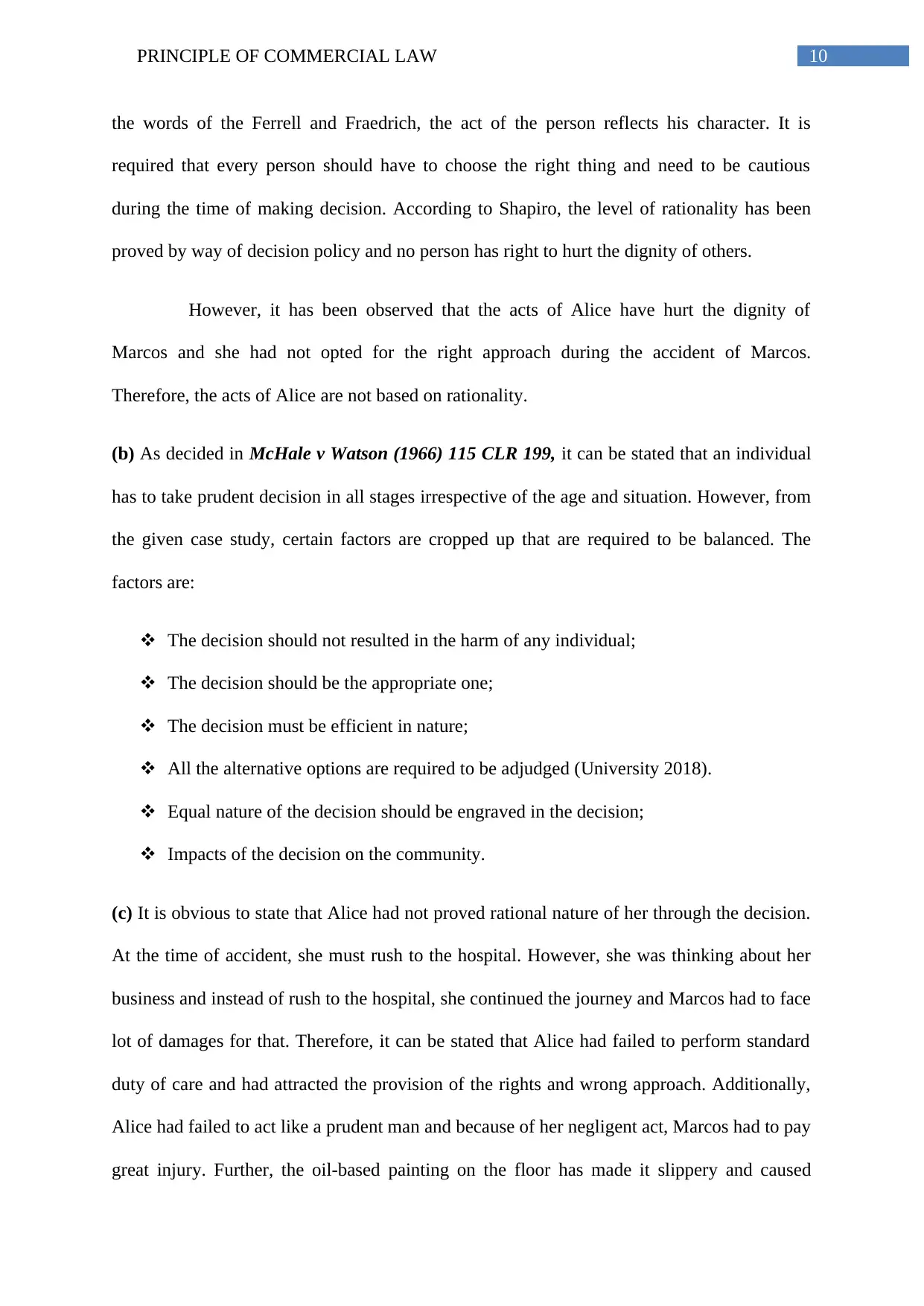
10PRINCIPLE OF COMMERCIAL LAW
the words of the Ferrell and Fraedrich, the act of the person reflects his character. It is
required that every person should have to choose the right thing and need to be cautious
during the time of making decision. According to Shapiro, the level of rationality has been
proved by way of decision policy and no person has right to hurt the dignity of others.
However, it has been observed that the acts of Alice have hurt the dignity of
Marcos and she had not opted for the right approach during the accident of Marcos.
Therefore, the acts of Alice are not based on rationality.
(b) As decided in McHale v Watson (1966) 115 CLR 199, it can be stated that an individual
has to take prudent decision in all stages irrespective of the age and situation. However, from
the given case study, certain factors are cropped up that are required to be balanced. The
factors are:
The decision should not resulted in the harm of any individual;
The decision should be the appropriate one;
The decision must be efficient in nature;
All the alternative options are required to be adjudged (University 2018).
Equal nature of the decision should be engraved in the decision;
Impacts of the decision on the community.
(c) It is obvious to state that Alice had not proved rational nature of her through the decision.
At the time of accident, she must rush to the hospital. However, she was thinking about her
business and instead of rush to the hospital, she continued the journey and Marcos had to face
lot of damages for that. Therefore, it can be stated that Alice had failed to perform standard
duty of care and had attracted the provision of the rights and wrong approach. Additionally,
Alice had failed to act like a prudent man and because of her negligent act, Marcos had to pay
great injury. Further, the oil-based painting on the floor has made it slippery and caused
the words of the Ferrell and Fraedrich, the act of the person reflects his character. It is
required that every person should have to choose the right thing and need to be cautious
during the time of making decision. According to Shapiro, the level of rationality has been
proved by way of decision policy and no person has right to hurt the dignity of others.
However, it has been observed that the acts of Alice have hurt the dignity of
Marcos and she had not opted for the right approach during the accident of Marcos.
Therefore, the acts of Alice are not based on rationality.
(b) As decided in McHale v Watson (1966) 115 CLR 199, it can be stated that an individual
has to take prudent decision in all stages irrespective of the age and situation. However, from
the given case study, certain factors are cropped up that are required to be balanced. The
factors are:
The decision should not resulted in the harm of any individual;
The decision should be the appropriate one;
The decision must be efficient in nature;
All the alternative options are required to be adjudged (University 2018).
Equal nature of the decision should be engraved in the decision;
Impacts of the decision on the community.
(c) It is obvious to state that Alice had not proved rational nature of her through the decision.
At the time of accident, she must rush to the hospital. However, she was thinking about her
business and instead of rush to the hospital, she continued the journey and Marcos had to face
lot of damages for that. Therefore, it can be stated that Alice had failed to perform standard
duty of care and had attracted the provision of the rights and wrong approach. Additionally,
Alice had failed to act like a prudent man and because of her negligent act, Marcos had to pay
great injury. Further, the oil-based painting on the floor has made it slippery and caused
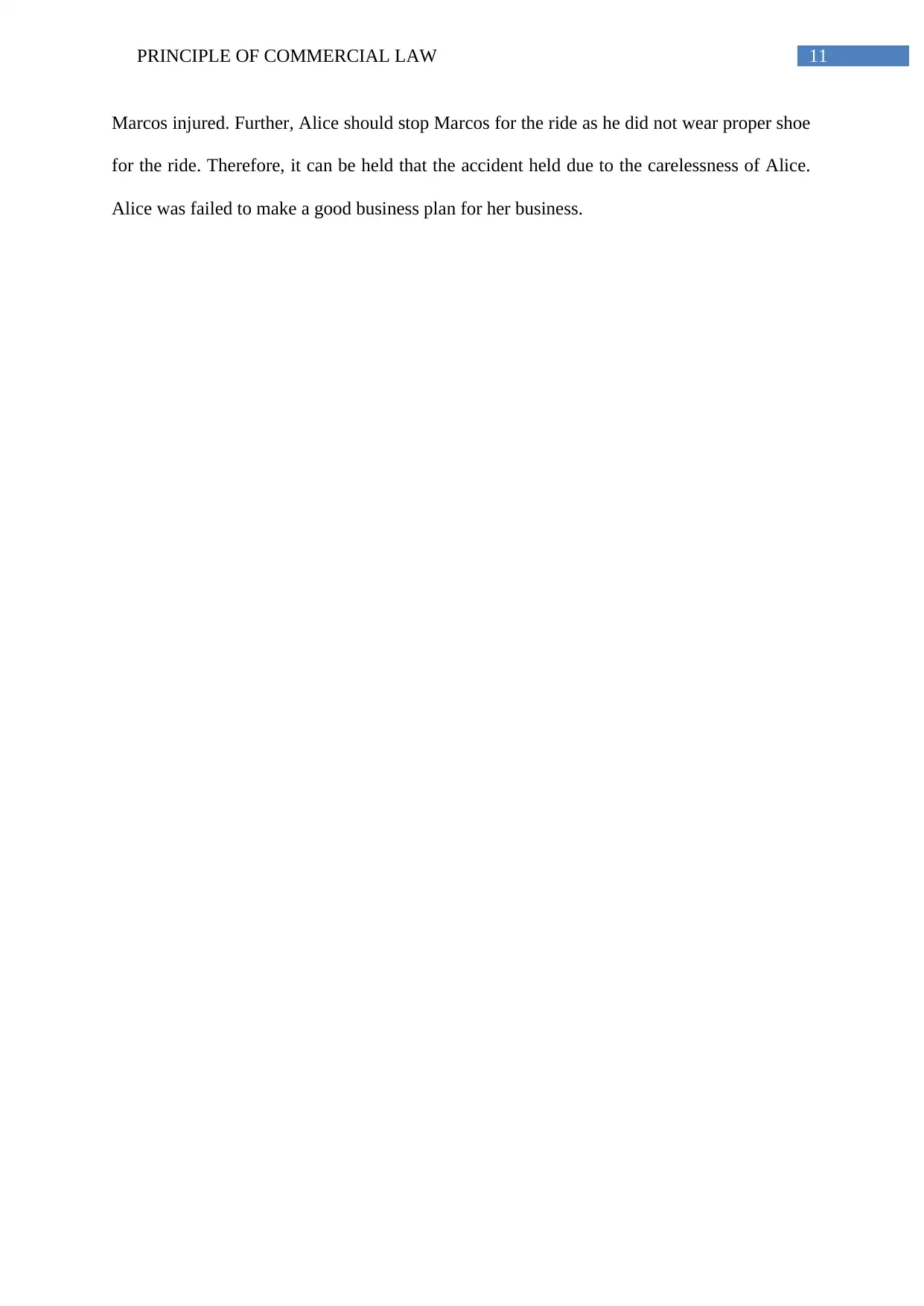
11PRINCIPLE OF COMMERCIAL LAW
Marcos injured. Further, Alice should stop Marcos for the ride as he did not wear proper shoe
for the ride. Therefore, it can be held that the accident held due to the carelessness of Alice.
Alice was failed to make a good business plan for her business.
Marcos injured. Further, Alice should stop Marcos for the ride as he did not wear proper shoe
for the ride. Therefore, it can be held that the accident held due to the carelessness of Alice.
Alice was failed to make a good business plan for her business.
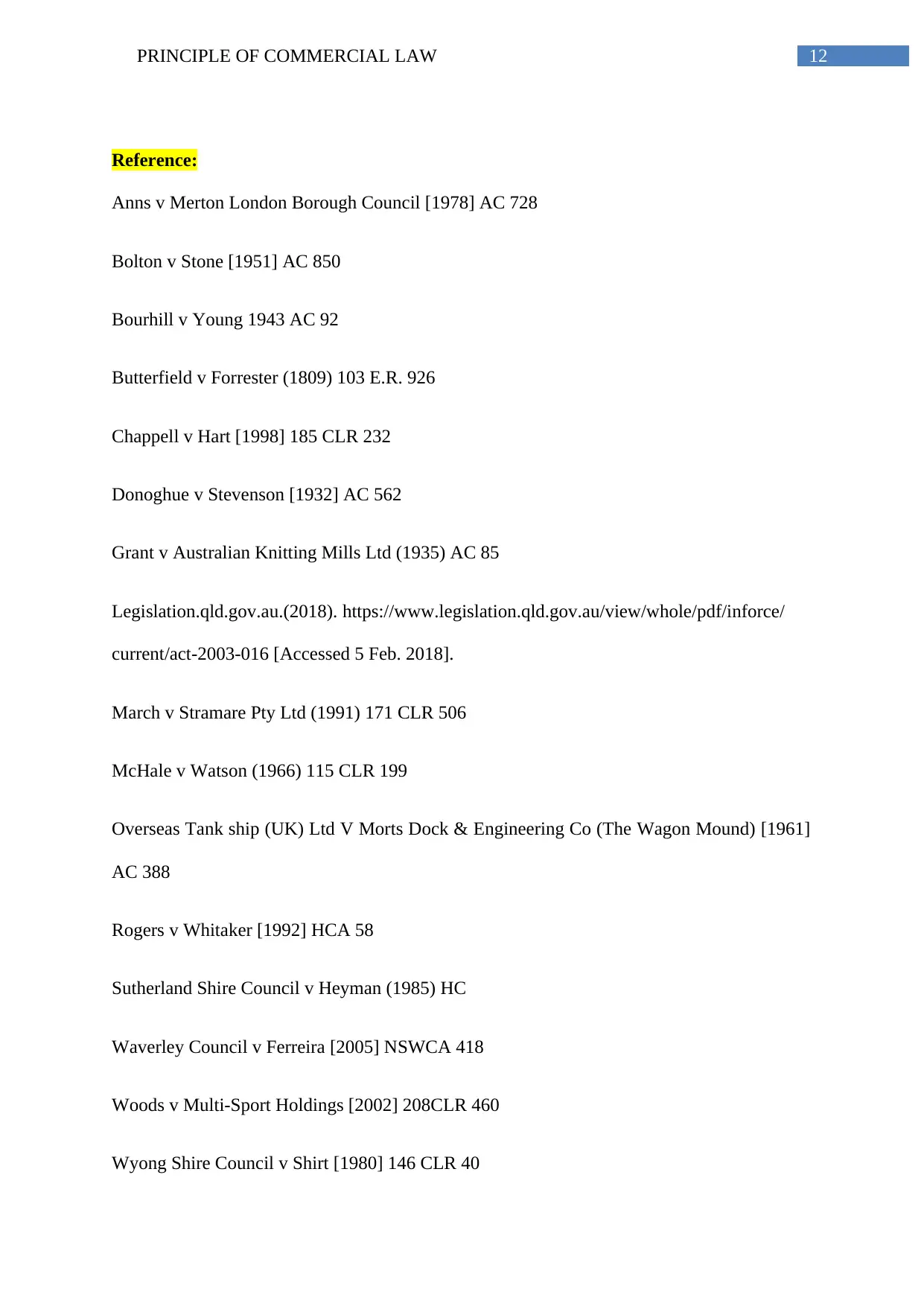
12PRINCIPLE OF COMMERCIAL LAW
Reference:
Anns v Merton London Borough Council [1978] AC 728
Bolton v Stone [1951] AC 850
Bourhill v Young 1943 AC 92
Butterfield v Forrester (1809) 103 E.R. 926
Chappell v Hart [1998] 185 CLR 232
Donoghue v Stevenson [1932] AC 562
Grant v Australian Knitting Mills Ltd (1935) AC 85
Legislation.qld.gov.au.(2018). https://www.legislation.qld.gov.au/view/whole/pdf/inforce/
current/act-2003-016 [Accessed 5 Feb. 2018].
March v Stramare Pty Ltd (1991) 171 CLR 506
McHale v Watson (1966) 115 CLR 199
Overseas Tank ship (UK) Ltd V Morts Dock & Engineering Co (The Wagon Mound) [1961]
AC 388
Rogers v Whitaker [1992] HCA 58
Sutherland Shire Council v Heyman (1985) HC
Waverley Council v Ferreira [2005] NSWCA 418
Woods v Multi-Sport Holdings [2002] 208CLR 460
Wyong Shire Council v Shirt [1980] 146 CLR 40
Reference:
Anns v Merton London Borough Council [1978] AC 728
Bolton v Stone [1951] AC 850
Bourhill v Young 1943 AC 92
Butterfield v Forrester (1809) 103 E.R. 926
Chappell v Hart [1998] 185 CLR 232
Donoghue v Stevenson [1932] AC 562
Grant v Australian Knitting Mills Ltd (1935) AC 85
Legislation.qld.gov.au.(2018). https://www.legislation.qld.gov.au/view/whole/pdf/inforce/
current/act-2003-016 [Accessed 5 Feb. 2018].
March v Stramare Pty Ltd (1991) 171 CLR 506
McHale v Watson (1966) 115 CLR 199
Overseas Tank ship (UK) Ltd V Morts Dock & Engineering Co (The Wagon Mound) [1961]
AC 388
Rogers v Whitaker [1992] HCA 58
Sutherland Shire Council v Heyman (1985) HC
Waverley Council v Ferreira [2005] NSWCA 418
Woods v Multi-Sport Holdings [2002] 208CLR 460
Wyong Shire Council v Shirt [1980] 146 CLR 40
Paraphrase This Document
Need a fresh take? Get an instant paraphrase of this document with our AI Paraphraser
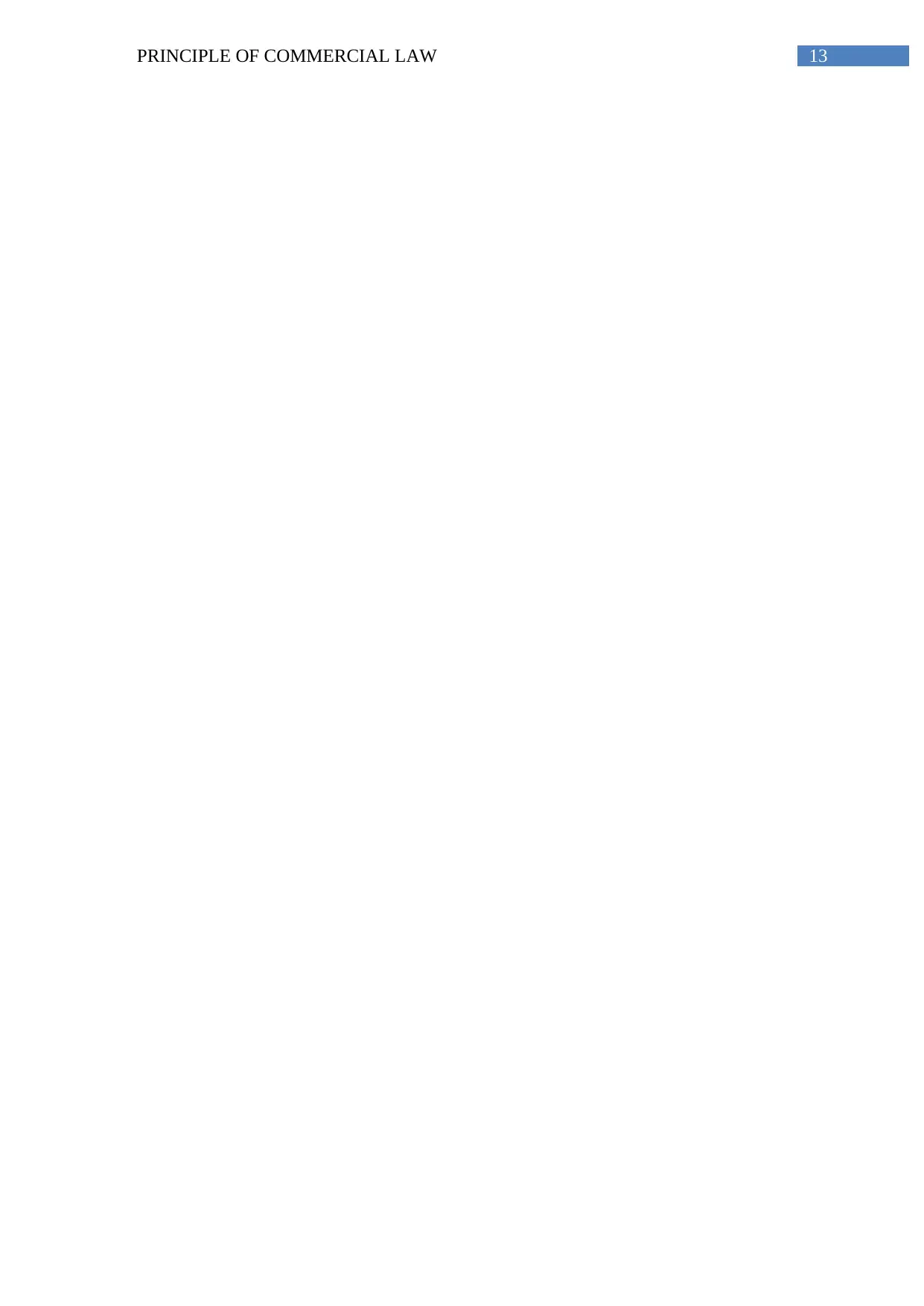
13PRINCIPLE OF COMMERCIAL LAW
1 out of 14
Related Documents
Your All-in-One AI-Powered Toolkit for Academic Success.
+13062052269
info@desklib.com
Available 24*7 on WhatsApp / Email
![[object Object]](/_next/static/media/star-bottom.7253800d.svg)
Unlock your academic potential
© 2024 | Zucol Services PVT LTD | All rights reserved.




![[Assignment] Tort Law: What It Is and How It Works](/_next/image/?url=https%3A%2F%2Fdesklib.com%2Fmedia%2Fimages%2Fok%2F2b08865474e740a9adc0e405894c8dc1.jpg&w=256&q=75)
